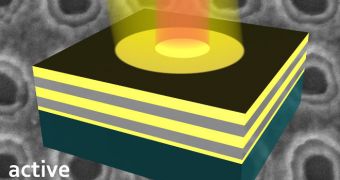Metamaterials are a very special class of materials that are engineered specifically for a certain job. Though they are basically common chemical elements, or mixes thereof, their internal structures are arranged differently than they are in nature. As such, metamaterials can be used for a variety of applications for which common elements are unsuited. One such application is in the field of optical physics, more specifically in the construction of ultra-powerful microscopes or even invisibility cloaks.
But one of the fundamental problems associated with using these materials is the fact that they absorb too much light. They oftentimes contain chemicals such as gold or silver in their make-up, and these elements are known for attracting light. If experts want to use metamaterials to produce an invisibility clok, for example, they need to bend the light around a target object only, not lose any photons in the process. The same amount of light that hits the concealed object needs to be bent around it, and then transmitted onwards, so that observers cannot notice any discrepancies in the space they're viewing.
Another negative side-effect of the fact that metamaterials trapped light was the fact that this made them unsuitable for applications in optical physics. Now, thanks to investigators at the Purdue University, that limitation is a thing of the past. After three years of study at the Purdue Birck Nanotechnology Center (BNC), experts finally came up with a solution to this problem. “This finding is fundamental to the whole field of metamaterials. We showed that, in principle, it's feasible to conquer losses and develop these materials for many applications,” says the Purdue Robert and Anne Burnett Professor of Electrical and Computer Engineering, Vladimir M. Shalaev.
The team managed to develop a fairly interesting material. It's fishnet-like film, laden with holes with a diameter of around 100 nanometers. The film is made up of repeating layers of silver and aluminum oxide, and this makes it act as a metamaterial. Inside the construct, a portion of an aluminum oxide layer is removed, and then replaced with a light-amplifying dye. The dye performs a very simple task, and namely boosts the amount of light going out of the material until all natural losses are compensated for. Details of how the technology functions appear in the latest issue of the esteemed scientific journal Nature.

 14 DAY TRIAL //
14 DAY TRIAL //